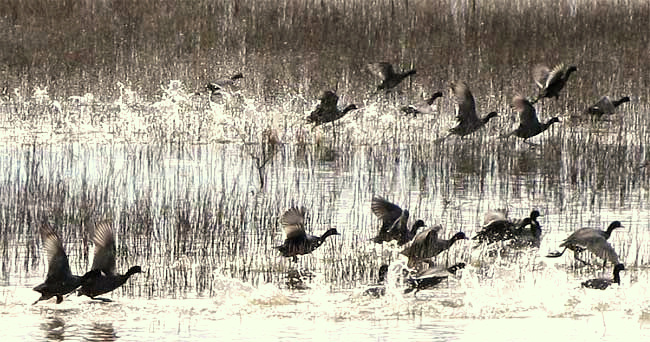Excerpts from Jim Conrad's
Naturalist Newsletter

from the the March 2, 2009 Newsletter, issued from the forest near Natchez, Mississippi; elevation ~400ft (120m), ~N31.47°, ~W91.29°:
COOTS
This week Karen and I visited St. Catherine Creek National Wildlife Refuge 13 miles south of Natchez and situated in the Mississippi River's floodplain. At this time of year the refuge's big, flooded fields are a paradise for waterfowl. By a very large margin, the most commonly seen bird in the fields' open water was the American Coot, FULICA AMERICANA, shown above.
Though 50 years ago in Kentucky I also saw lots of coots, coot numbers in the refuge were so impressive that I wondered whether maybe coot populations have been expanding at the expense of duck species. Maybe one reason coots are so successful is that they eat a large variety of submerged vegetation. A coot would dive briefly and come up with a mass of green, stringy vegetation several inches long, which might take a fair amount of time to swallow -- especially when other coots tried to snatch it from the diver's beak. There was so much submerged food easily available that it seemed to me coots tried to snatch food from their neighbors more for the fun of it than for the diving work they could have saved themselves.
Despite coots looking like ducks at a distance, coots aren't ducks. Ducks belong to the Waterfowl Order, the Anseriformes, containing not only ducks but also geese, swans and other ducky species. Coots are members of the Crane Order, the Gruiformes, holding cranes, rails and limpkins. Instead of having completely webbed feet like ducks, coot feet bear "scalloped" toes -- the toes' sides bearing skin flaps that fold behind the toes when the foot is passing forward through the water, but which flair out pushing against the water when the foot is moving backward. Also, instead of having flat beaks like ducks, you can see that coot beaks are higher than flatter.

In the picture above a flock of coots is taking off from the water and you can see that they don't "jump" from the water like some duck species. Coots seem to have a hard time getting aloft, during part of the takeoff actually running atop the water, splashing noisily and picturesquely. Look at that coot in the lower right to see what a water-top-running coot looks like.
During the summer breeding season coots are found in wetlands throughout the US and southern and western Canada, but during the winter they withdraw from most of Canada and the northern US, except in the Pacific Northwest. Here they occur year round.
As a kid in Kentucky I was taught to call coots Mud Hens. Maybe they got that name by the way they bob their heads back and forth as they walk and swim, just like an old hen in a chicken yard.
I mentioned "a flock of coots" but actually there are more specific words for designating coot gatherings. Groups of coots are called "covers" or "rafts." If you could have seen how black some of the flooded fields were this week with coots, you'd agree that "a cover of coots" makes sense.
from the January 12, 2007 Newsletter, issued from Jalpan, Querétaro, México
Seeing coots mentioned in last week's Newsletter, Ethel in Minnesota wrote:
When do coots arrive in the Yucatan and do you suppose some of them come from Minnesota? For the last week there have been uncountable numbers of them on Lake Minnetonka - they arrive suddenly when the weather begins to get cold and disappear just as suddenly, and I often wonder how far they go each year...
The only way I knew to figure out where Minnesota coots overwinter was to look for bird-banding data -- information on where birds who have been banded in Minnesota turn up later.
A website produced by the US Fish & Wildlife Service provided that information in a user-friendly format here.
On that page you can conduct a four-step search for bird banding information on waterfowl such as ducks, geese, swans and other "game birds," but not other kinds of birds such as songbirds.
In Step One I, under "Other Game Birds" I chose "Coot." In Step Two, the "Banded In" step, I tagged "State" and chose "Minnesota. In Three, I clicked on "Recovered In" and tagged "Anywhere." In Four, I tagged "All Years" and clicked on "Go."
The resulting map showed 126 records, with Minnesota-banded coots turning up all along the Mississippi Flyway and beyond, as far south as central Mexico and Cuba. Learning that coots migrate so far south, I'll bet that some Minnesota coots do overwinter in the Yucatán.
What a hoot playing with this new page is. If someone knows of a similar page for other migratory birds, let me know and I'll pass it on.